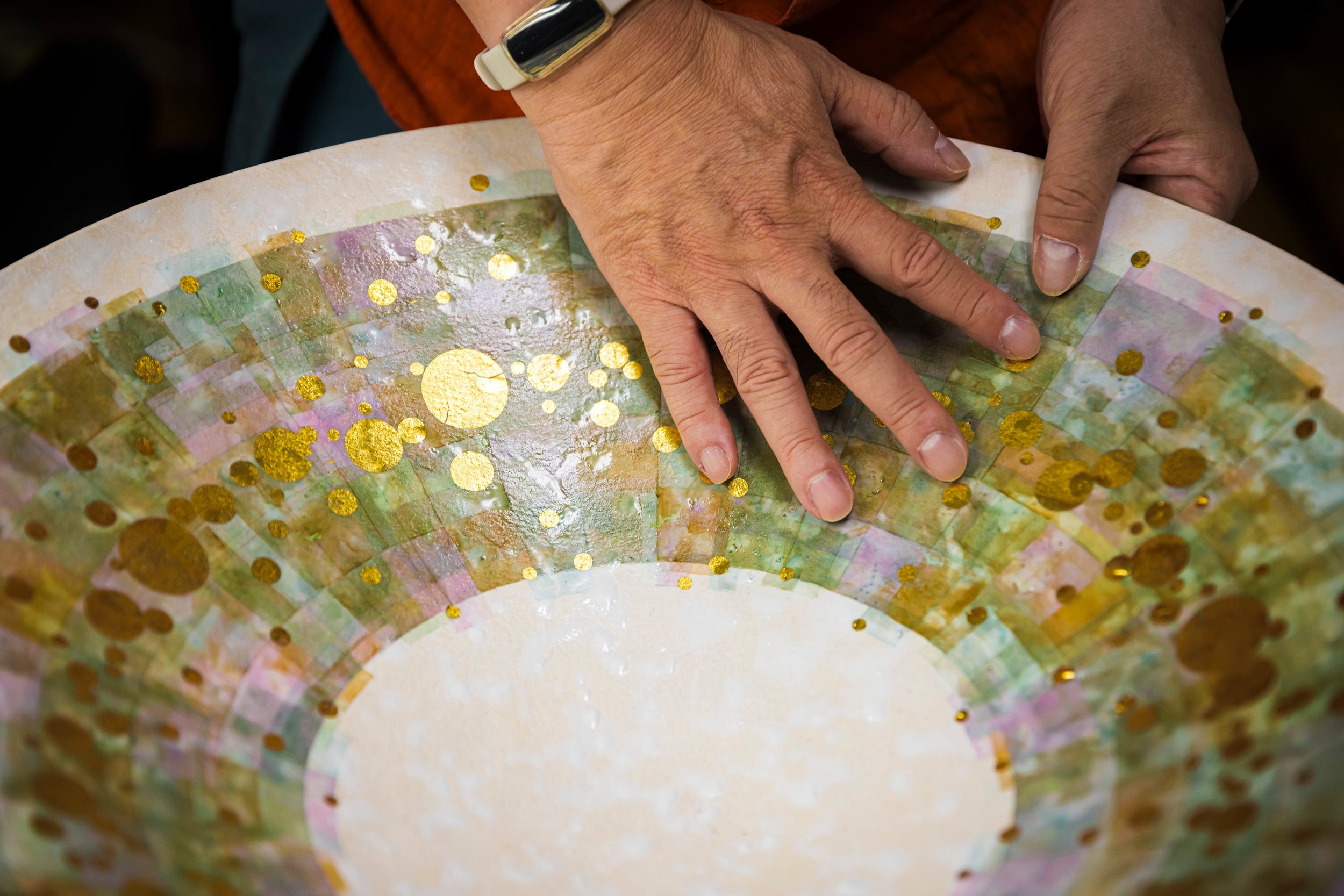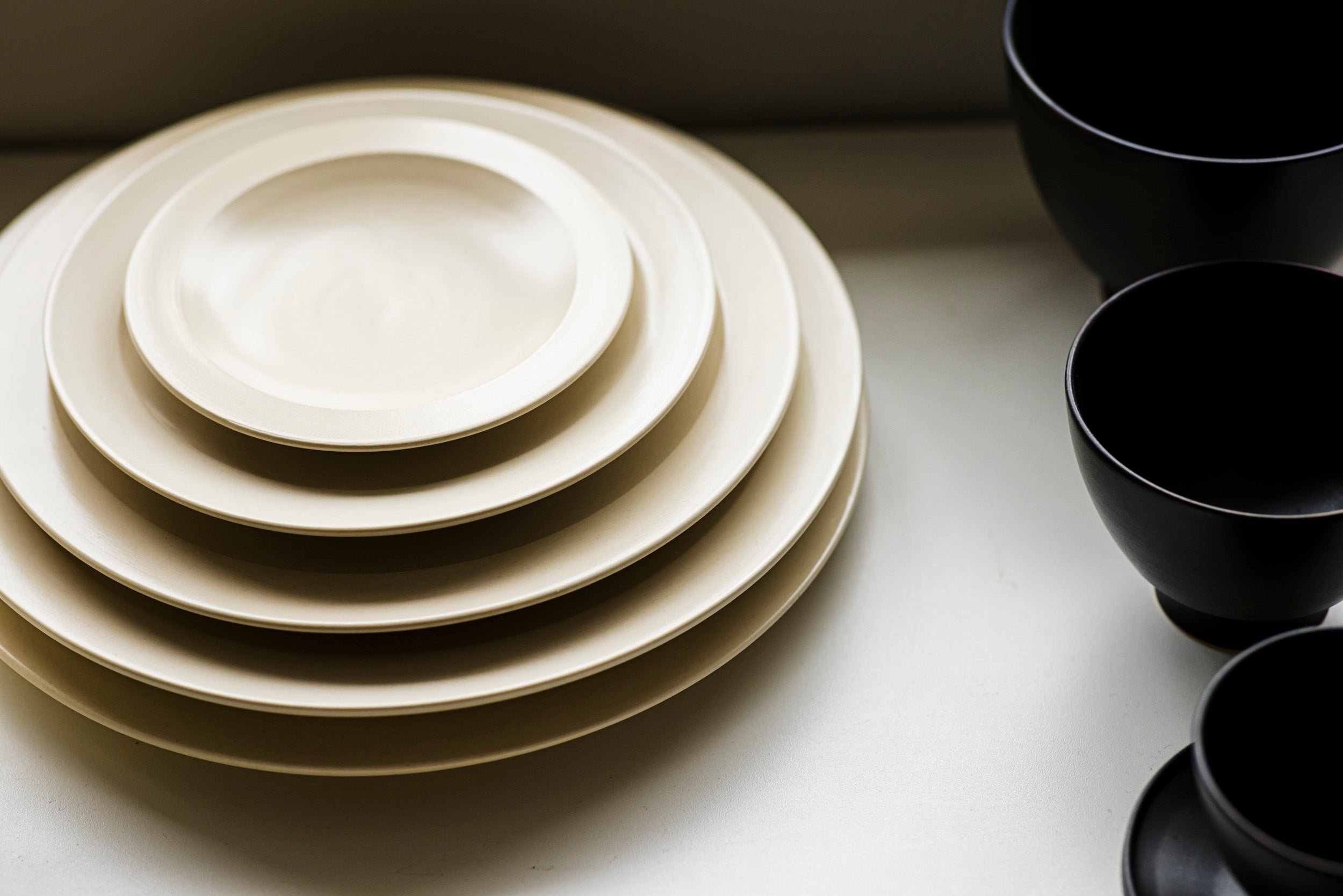
変化の時代に映える「錦山釜」【第二話】
伝統は何度でも生まれ変わる
九谷焼の伝統を受け継ぎつつ、一家全員がそれぞれの九谷焼を模索する「錦山釜」。その作品たちを見て、ある人は「伝統的だ」といい、またある人は「革新的だ」といいます。1世紀以上にわたる歴史の中で変わってきたものと変わらなかったもの。そこには、九谷焼の本質が垣間見える気がします。現在進行形ともいえる四代目幸夫さんと錦山窯の挑戦をご紹介します。

いま、また変革のとき
幸央さんの仕事場を訪れると、およそ伝統工芸の作家が仕事をしている空間とは思えない光景に驚かされます。三代目の美統さんの仕事場は畳のうえに座卓を置いているのに対して、巨大なモニターに向き合い、最新のMacを自在に操るよう様子は想像とかけ離れていました。
「これはソニーCSLの研究員であるアレクシー・アンドレと共同研究している『TOMONAMI』というアプリケーションになります。もう3年近くになりますが、Creativity Acceleration(創造性の加速)の研究として、伝統工芸を融合することで私のアウトプットにどのような変化が起きるか試しています。父の時代には窯の制御盤などの機械的な面で大きく進歩しましたが、いまの時代ではそれがデジタルになり、加速度的に進化している。時代に感覚が追いつかなくなる前に色々と試してみたいと思っているのです」
幸央さんの作品はいくつもの色を重ね、素地の質感を変え、金彩を施すことで多彩な表情を表現しています。その制作プロセスを「この開発においては、想像(クリエイション)と制作(手仕事)に分けてみている」と説明します。TOMONAMIはその想像(クリエイション)部分を高速化するというもの。
「頭の中ではせいぜい8色くらいを3つのレイヤーで構成するのが限界。それをスケッチでやっていたわけですから、実際に手を動かすまでに膨大な時間を費やしていました。しかも、制作の経験が増えると身体的な制限や技術的な限界がわかってしまい、それを超えようとは思わなくなってくるのです。TOMONAMIは私が撮影し、美しいと感じた写真画像から色味を抽出し、パラメーターで気持ち良いところに辿り着くまで無限のパターンを瞬時に展開することができます。このパラメータも私の思考プロセスや感覚に近づくようにチューニングしてあるので、私はこれまでの経験から評価していけば良い。自身もアーティストであるアレクシーは、この“アイデアを生む力”と、それを“評価する力”がクリエイティブの本質だと考えていて、試行錯誤のプロセスを高速化することで創作に新しい可能性を見出そうとしているのです。あくまで試行錯誤のプロセスを支えるツールであり、トレンドの生成AIや描画ツールが搭載されていない点も特徴で、私にとっては凝り固まった創造性を鍛え直すトレーニングルームのような存在です」

最新のMac Studioとディスプレイが並ぶ幸央さんの仕事場。

実際のカラーパレットも加速度的に増えていく。

白の中にもテクスチャーで表情の違いを出す。

「TOMONAMI」によって作品にどのような変化が出たのか。

試行錯誤もどこか楽しそうだ。
世界観を表現したギャラリー「嘸旦(MUTAN)」
そして錦山釜としては、2019年にアトリエから徒歩で数分の場所にギャラリー「嘸旦(MUTAN)」を建設します。柔らかな黄色が特徴的な「観音下(かながそ)」石の建物は、シンプルながら存在感が際立ちます。入り口はアプローチから建物をぐるりと反対側に回り込んだ場所にあり、「気持ちを切り替えるための所作」と、みふゆさんは話します。シンプリシティの緒方慎一郎さんがコンセプトデザインを手掛けたという空間には窓がなく、トップライトの明かりのみという潔さ。まるで教会のような静謐な空気のなか、錦山釜の作品たちが並びます。ギャラリーを立ちあげた経緯について幸央さんに伺いました。
「嘸旦というのは音のない始まり、ゼロからのスタートを意味しています。これまでの錦山釜を一度リセットして、これから新しい錦山釜を始めよう、ということで立ちあげたギャラリーです。作家の個展を始め、金箔を貼るワークショップやJAZZのライブ、お茶会、食事会など、さまざまなイベントで活用しています。九谷焼は飾られることも多く、使われるとしてもお正月などのハレの日が多い。しかし、わたしたちは子供の頃から九谷焼のお椀でご飯を食べていたのです。使っているうちに下地が見えてきて、味が出てくる。そんな普段使いの久谷焼も良いものなのです。そこで、作り手であるわたしたちが直接ゲストを招き、食事を振る舞って実際に使ってもらう。一緒にお茶を飲みながら、さまざまな交流ができる場所なんです」
それぞれの作家の作品が並ぶなか、ひときわ目を惹くのが大きく割れた作品たち。2024年元旦の「能登半島地震」で被災した作品たちです。重力や災害といった世の無情とひきかえに、何気ない日常がどれだけ有り難いことか思い知らせられます。儚さや美しさをありありと伝えるその存在は、眺めていると目が離せません。無からの始まりを意味するこのギャラリーを象徴するようで、錦山釜の姿勢と未来へ向かう意思を表しているように感じました。

結界のようなアプローチがユニークだ。

蔵など街のあちこちで使われる「観音下(かながそ)」石。

自然と剥がれていく扉の金箔も風情がある。

石、土、泥。同じ大地の素材がさまざまな表情をみせる。

これらもすべて同じ地球から生まれたものたち。

儚く緊張感のある美しさは衝撃的。
そしていま、新しい伝統が生まれる
小松市では「小松式土器」と呼ばれる弥生時代の遺跡や古墳時代の須恵器(すえき)を焼いていた窯などが出土しており、古来より北陸地方を代表する文化圏だったとされています。また、観音下石(かながそいし)や凝灰岩(ぎょうかいがん)など良質な石材が産出される「石の里」として、天然資源が豊富だった様子がうかがえます。弥生時代には「碧玉(へきぎょく)」を求めて権力者が争い、装飾品などのものづくりが隆盛を極めます。九谷焼の本質について幸央さんに伺いました。
「歴史を振り返れば、九谷焼も有田焼も区別がない時代から、人々は道具を作ったり美しい装飾品を求めていたのが分かります。錦山釜でも美術品だけでなくプロダクトデザイナーの吉田守孝を迎えて、「酒具-Shugu」という酒器のシリーズなども作っています。そういう意味では、“何が九谷焼か”という定義よりも常に新しさを求め、肉体を研ぎ澄ますことで獲得した伝統技法によって最高のものを追い求める姿勢こそが九谷焼の本質ではないでしょうか。それでは厳格に線を引くことは難しいですが、さらに加えるなら“足し算の美学”だと思います。とかく、日本の美意識として禅や侘び寂びが取り上げられますが、祭りや歌舞伎など、派手で艶やかなセンスも持ち合わせているのです。少なくとも私の作品では鮮やかな色彩や金彩、質感の違いなど、どこかに手を加えて華やかさを目指しています。われわれ伝統工芸作家はひたすらに技術を磨き、さまざまな影響を受けながら感性を育み、さまざまな御縁と時代の変化に寄り添いながら作品を作り続ける。その根っこに九谷焼の伝統があることは間違いありません」
機能と効率が優先され、シンプルでミニマルな価値観がトレンドの現代にあって、華やかで美しい九谷焼の雅な佇まいは「もっと毎日を楽しもう」と、わたしたちの暮らしを鼓舞しているようにさえ感じます。

お酒やお茶を嗜む日常的な九谷焼の艶やかな存在感。

このむせるほど濃密な美しさは他に類を見ない。

歴史と変革、伝統と革新。その狭間に錦山釜の現在がある。

こうした華やかさを楽しめる暮らしをしたい。



![Tea: A Tool for Savoring Time [Part 1]](http://tabaya-unitedarrows.com/cdn/shop/articles/img-1739144687588_66836a19-b7c3-49fb-84ea-42ee3d4a44ee.jpg?v=1739180069&width=2500)